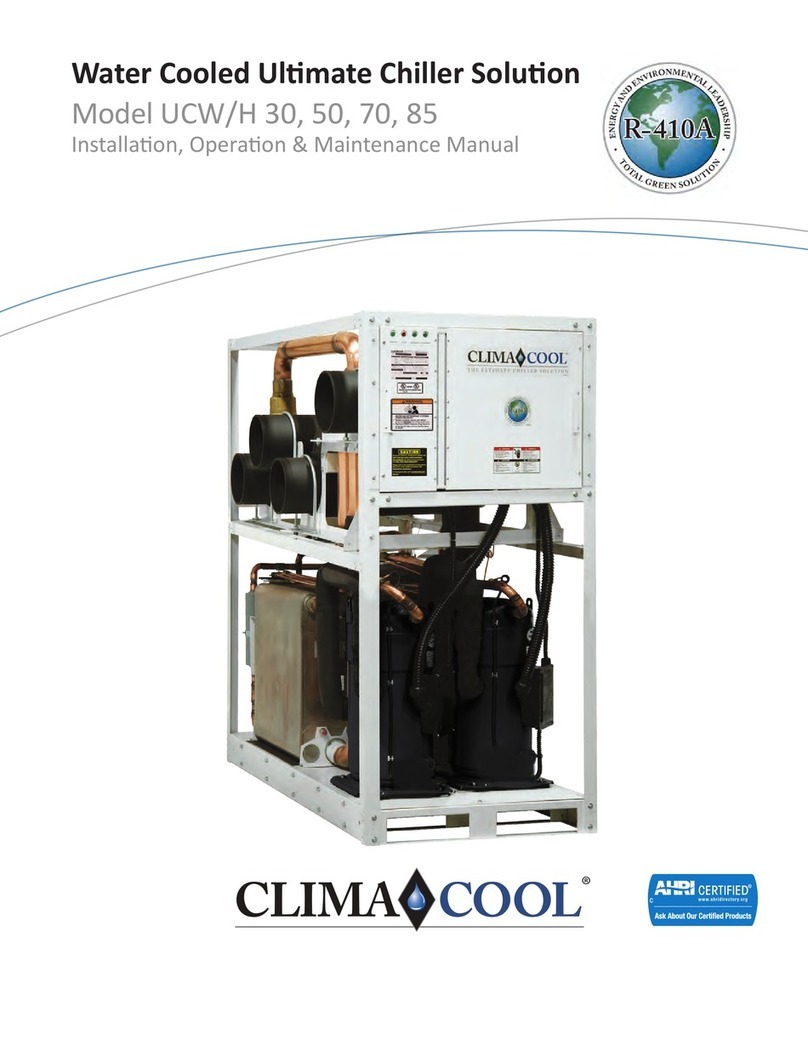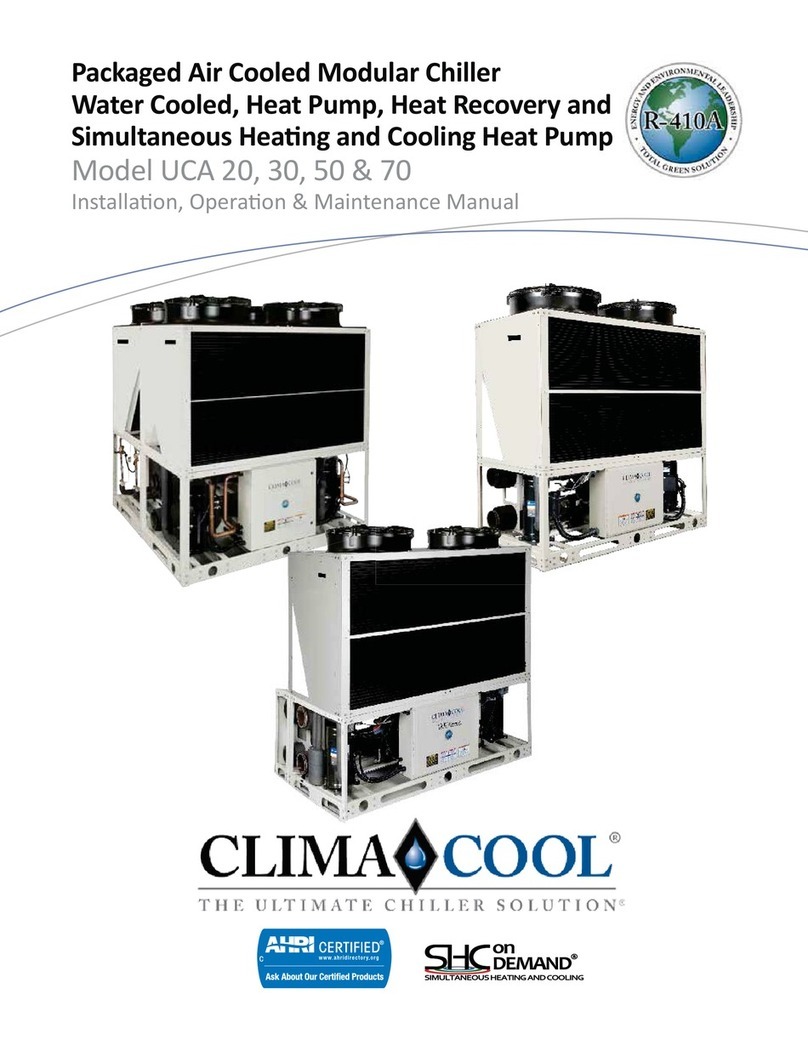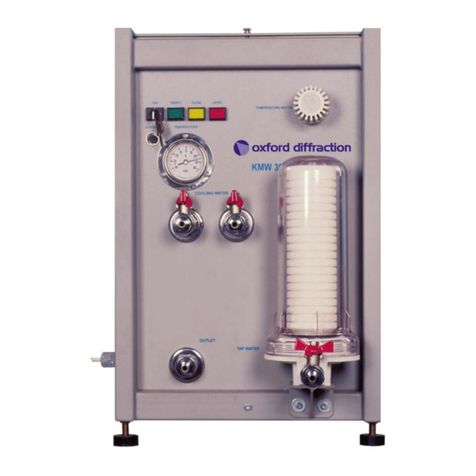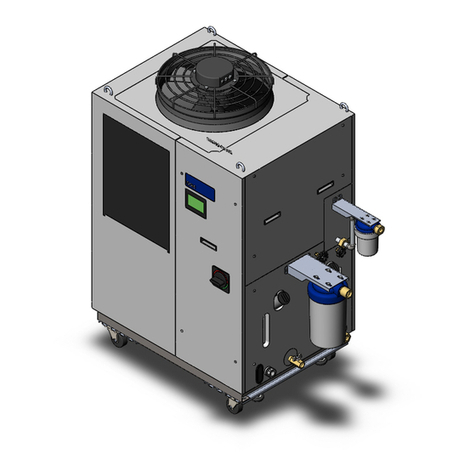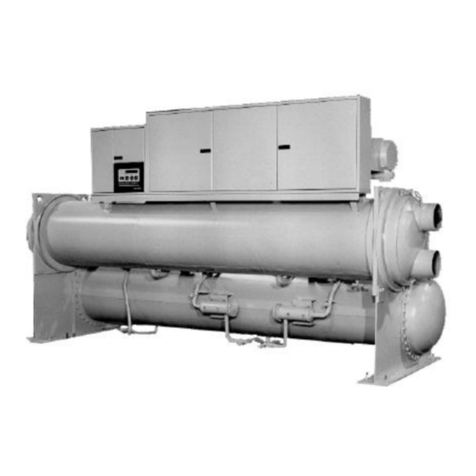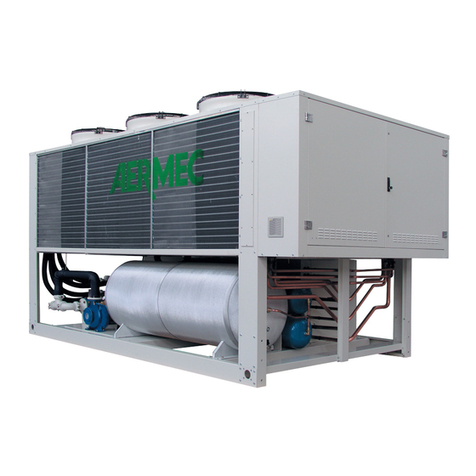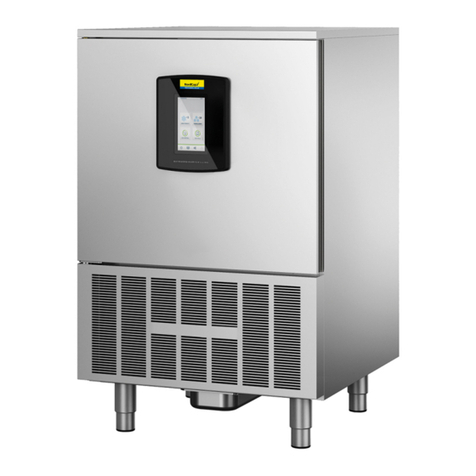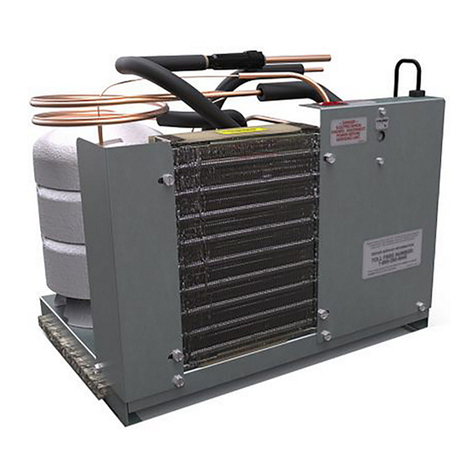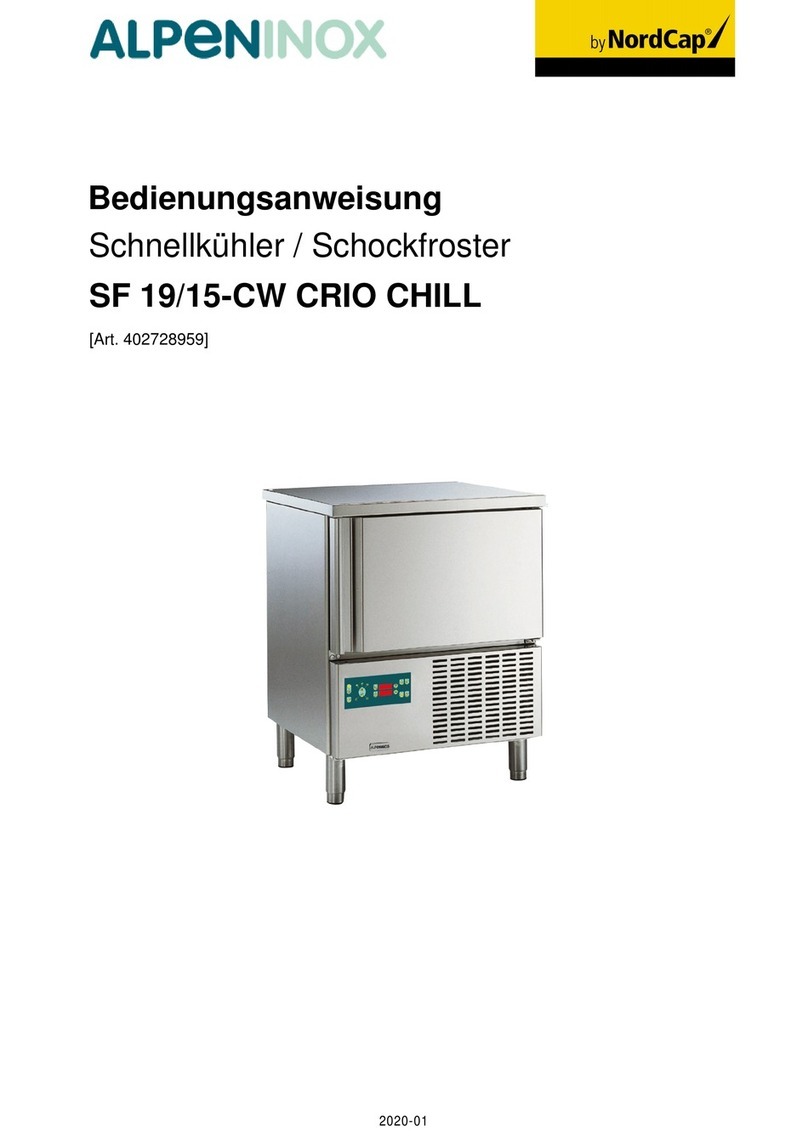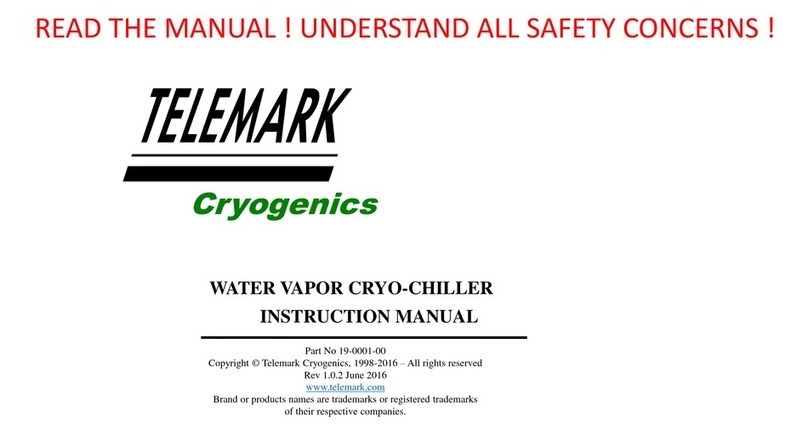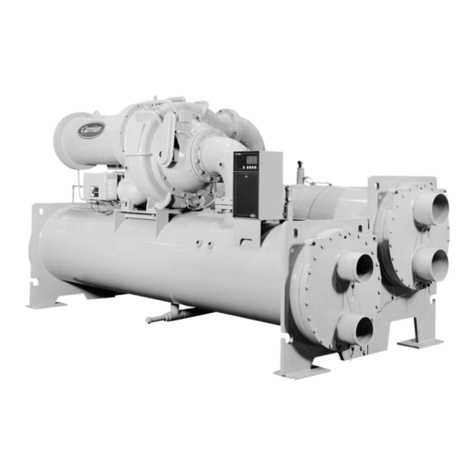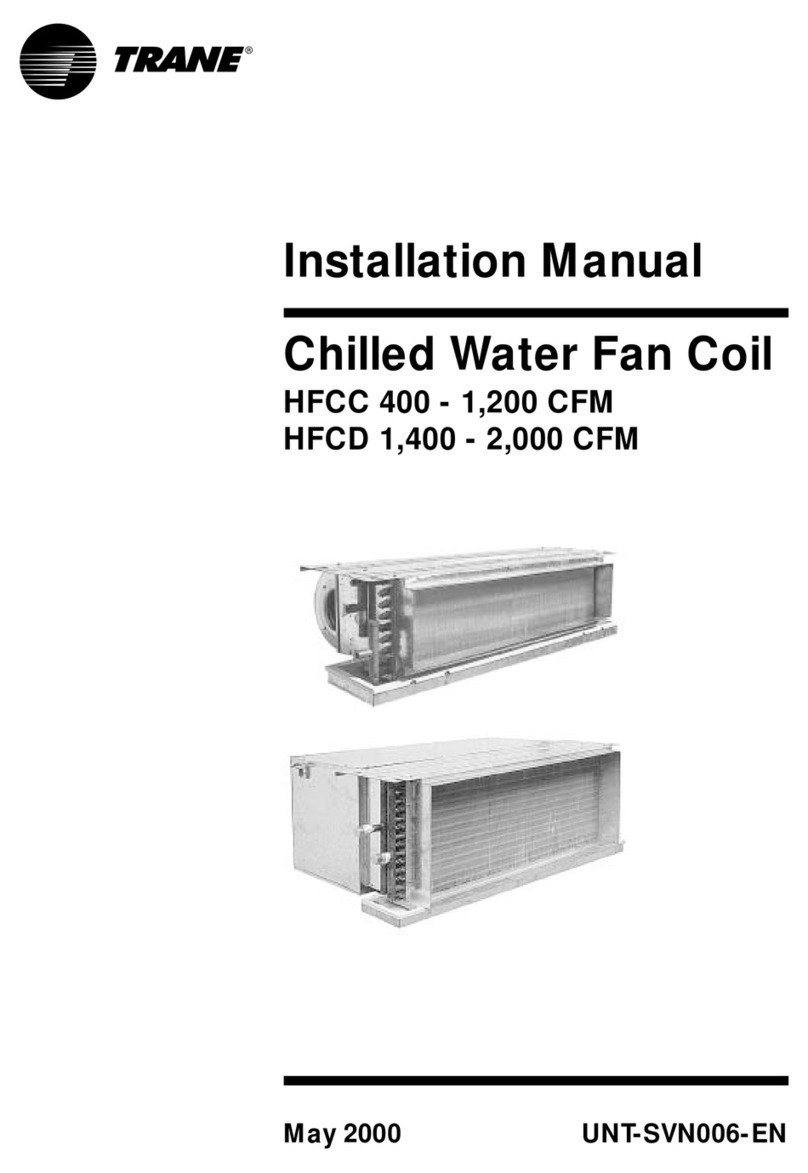ClimaCool FLEX Series Instruction manual

®
Installation, Operation &
Maintenance Manual
ClimaCool IOM
FLEX SERIES
Water-Cooled Modular Chillers

^^^JSPTHJVVSJVYWJVT^^^JSPTHJVVSJVYWJVT
®
2
ClimaCool works continually to improve
its products. As a result, the design and
specifications of each product at the time for
order may be changed without notice and
may not be as described herein. Please contact
ClimaCool's Customer Service Department at
(405) 745-3185 for specific information on the
current design and specifications. Statements
and other information contained herein are not
express warranties and do not form the basis
of any bargain between the parties, but are
merely ClimaCool's opinion or commendation
of its products.
Refer to www.climacoolcorp.com for complete
warranty details.

^^^JSPTHJVVSJVYWJVT
®1
ClimaCool Modular Chillers
MODEL NUMBERS AND SPECIFICATIONS
Dimensions Refrigerant No. Of Nominal
Model No. L x W x H (in.) Voltage Circuits Compressors Tons
FLEX 30 41-7/8” x 29-1/2” x 77”* 208/230/3/60 2 2 30
FLEX 30 41-7/8” x 29-1/2” x 77 ”* 460/3/60 2 2 30
FLEX 30 41-7/8” x 29-1/2” x 77 ”* 575/3/60 2 2 30
FLEX 50 41-7/8” x 33-1/2” x 78 3/8”* 208/230/3/60 2 2 50
FLEX 50 41-7/8” x 33-1/2” x 78 3/8”* 460/3/60 2 2 50
FLEX 50 41-7/8” x 33-1/2” x 78 3/8”* 575/3/60 2 2 50
FLEX 65 43-5/8” x 33-1/2” x 78 3/8”* 208/230/3/60 2 2 65
FLEX 65 43-5/8” x 33-1/2” x 78 3/8”* 460/3/60 2 2 65
FLEX 65 43-5/8” x 33-1/2” x 78 3/8”* 575/3/60 2 2 65
* Dimensions with covers.
CONTENTS PAGES
Model Numbers/Safety . . . . . . . . . . . . . . . . . . . . . . . . . . . . . 1
Inspection ....................................2
Site Preparation .................................3
Installation . . . . . . . . . . . . . . . . . . . . . . . . . . . . . . . . . . . 3
Dimensional Data ................................4
Rigging and Lifting ...............................5
Service Clearances . . . . . . . . . . . . . . . . . . . . . . . . . . . . . . . 6
Vibration Isolation . . . . . . . . . . . . . . . . . . . . . . . . . . . . . . . 7
Electrical Connection ..............................8
Water Piping System . . . . . . . . . . . . . . . . . . . . . . . . . . . . . . 9
Water Piping Configurations . . . . . . . . . . . . . . . . . . . . . . . . . .10
Hydronic Refrigeration (Drawing) . . . . . . . . . . . . . . . . . . . . . . .11
Filling the Water System . . . . . . . . . . . . . . . . . . . . . . . . . . . . 12
Water Treatment . . . . . . . . . . . . . . . . . . . . . . . . . . . . . . . . 13
Condenser Water Temperature Requirements . . . . . . . . . . . . . . . . . 14
Strainer Systems . . . . . . . . . . . . . . . . . . . . . . . . . . . . . . . . 15
Stainless Steel Strainer Option . . . . . . . . . . . . . . . . . . . . . . . . . 16
Automatic Timer Flush Package Option . . . . . . . . . . . . . . . . . . . . 18
Pressure Differential Alarm Package . . . . . . . . . . . . . . . . . . . . . . 21
Y Type and Basket Type Strainers . . . . . . . . . . . . . . . . . . . . . . . 23
Pre-Start Up...................................24
Start Up . . . . . . . . . . . . . . . . . . . . . . . . . . . . . . . . . . . . . 25
Pre-Start Up Check List . . . . . . . . . . . . . . . . . . . . . . . . . . . . 26
Start-Up and Warranty Registration Form . . . . . . . . . . . . . . . . . . .27
Chiller Operation and Maintenance.......................28
Heat Exchangers (Drawings) . . . . . . . . . . . . . . . . . . . . . . . . . . 29
Operation Limitations..............................30
Physical Data . . . . . . . . . . . . . . . . . . . . . . . . . . . . . . . . . .31
Application Parameters .............................32
Compressor Information . . . . . . . . . . . . . . . . . . . . . . . . . . . . 33
Refrigeration Circuit (Drawings) ........................34
Refrigeration System Re-Processing . . . . . . . . . . . . . . . . . . . . . . 36
Sequence of Operation . . . . . . . . . . . . . . . . . . . . . . . . . . . . . 37
Electrical Data . . . . . . . . . . . . . . . . . . . . . . . . . . . . . . . . . 38
Power Distribution (Drawing) . . . . . . . . . . . . . . . . . . . . . . . . .39
Wiring Diagrams . . . . . . . . . . . . . . . . . . . . . . . . . . . . . . . . 40
Troubleshooting Guide . . . . . . . . . . . . . . . . . . . . . . . . . . . . .43
Warranty Information ..............................45
High voltage is used to operate this equipment. Failure to observe standard electrical safety procedures may result in serious
injury. Only persons qualified and / or properly trained should attempt to install, operate and maintain this equipment. These
chillers come fully charged with refrigerant. Installation, and start – up should be accomplished by technicians who are fully
certified to handle refrigerants, as required by 40 CFR Part 82, subpart F of the Recycling and Emissions Reduction Act. Scroll
compressors are used in this equipment. Phase verification is required for proper rotation direction. Incorrect rotation will
result in elevated sound and internal overload trip failure.
ѥSAFETY WARNING ѥ

^^^JSPTHJVVSJVYWJVT^^^JSPTHJVVSJVYWJVT
®
2
INSPECTION
Allow a sufficient amount of time to carefully follow these
instructions to assure warranty coverage.
During inspection of the equipment remove the top doors
to check the equipment for any damage during shipment.
Inspect wiring connections, lines from expansion devices,
thermostats, and pressure switches for damage.
General
During any correspondence concerning this machine, always
reference the full model and serial numbers of your modules.
Receipt of the ClimaCool Modules
Upon receipt of the equipment, carefully check the shipment
against the bill of lading. Make sure all modules ordered have
been received. Inspect the carton or crating of each module,
and inspect each module for damage. You must make
proper notation of any shortages or damage on all copies
of the freight bill for your records. Make sure the carrier
completes a common carrier inspection report listing any
shortages or damage.
Note: It is the responsibility of the recipient of the
modules to file all necessary claims with the carrier. In
addition, please notify the ClimaCool Customer Service
Department of all damage immediately. Refer to the
back cover for the Customer Service Department phone
number.
Storage
Equipment should be stored as shipped in a clean, dry area.
Store modules in an upright position at all times. Plastic wrap
should be left on until the module is ready to be installed.
Handling of Modules
The packaging allows for handling by fork lift or pallet
jack (only lift the module from the side). See Lifting and
Transporting Modules (Fig. 3) on page 5. Caution: modules
ARE TOP HEAVY. Please use caution when rigging or
moving.
Rigging for Lifting
Each module should be lifted by using lift straps threaded
through each top header tube. See page 5 - Rigging and
Lifting Procedures.
ѥWARNING ѥ
To avoid the release of refrigerant into the atmosphere,
the refrigerant circuit of this unit must be serviced only by
technicians who meet local, state and federal proficiency
requirements.
All refrigerant discharged from this unit must be recovered
WITHOUT EXCEPTION. Technicians must follow industry
accepted guidelines and all local, state and federal statutes for
the recovery and disposal of refrigerants.
If a compressor is removed from this unit, system refrigerant
circuit oil will remain in the compressor. To avoid leakage of
compressor oil, the refrigerant lines of the compressor must
be sealed after it is removed.
Inspection

^^^JSPTHJVVSJVYWJVT
®3
Preparing for Installation.
Prepare the modules for installation by carefully removing
the module's packaging, unbolt the module from the skid, and
lift the module with a crane or hoist into its final position.
Hardware kits are shipped in separate packaging along with
the modules. Make sure the hardware kits are on site when
connecting the modules.
SITE PREPARATION
Base Requirements
The minimum base requirement for the ClimaCool chiller
is a level surface which has been checked to ensure that it
is capable of bearing the combined operating weight of the
modules (see page 4).
Anti-Vibration Mountings
Although the compressors are installed on anti-vibration
mountings, further isolation of the chiller from the structure
can be achieved by installing vibration-eliminating springs or
pads under the base rails on which the chiller will rest. (see
page 7 - Vibration Isolation).
Service Access
The minimum space required for electrical panel service is
36" in the front of each module. Allow 24" service clearance
in the back of the module for refrigeration access. Allow a
minimum of 18” of clearance above the module for service.
Allow 12” side clearance of any ClimaCool modular chiller
system (see Service Clearances page 6). Local building or
electrical codes may require additional clearance.
Draining
When performing standard maintenance procedures such
as flushing heat exchanger, it will be necessary to close off
a section of a module. ClimaCool modular chillers come
equipped with isolation valves for this purpose. Access to a
floor drain is helpful when performing standard maintenance
procedures.
INSTALLATION
Assembling Modules
Use of (2) 4” rails (minimum size) is required for ease of
installation. One of the end modules should be chosen as the
reference module and carefully located.
Site Preparation/Installation
A factory supplied fastener kit is provided for the adjoining
of each module. Each kit contains (4) gaskets, (32) ¾” fully
threaded studs, (64) heavy duty hex nuts, (64) lock washers,
and (64) flat washers.
A ¾"-10 tap should be run through each weld nut located at
the bottom rear chiller header flange of each module. Screw
the fully threaded studs into these four weld nut locations.
At all other flange hole locations, insert fully threaded studs,
attach washers, lock washers, and nuts from the fastener kit.
The gasket should be placed between the first reference
module and the next module. Slide the next module into
position while guiding the fully threaded studs into the flange
holes of the next module. Finally, the washers, lock washers,
and nuts are applied to the other end of the fully threaded
studs to securely fasten the module flanges.
Tighten the flange bolts in a diametrically opposite pattern,
in such a way as to pull the modules together evenly. It will
be necessary to use a ¾" (12 point) box-end wrench when
tightening. As each module is added, the alignment of the
whole package should be confirmed.
Header and Flange Insulation
Chilled water piping is pre-insulated on each module at the
factory with ¾” closed cell foam rubber. After the bolting the
modules together, the installer must apply insulation on site
over the chilled water header connection flanges.

^^^JSPTHJVVSJVYWJVT^^^JSPTHJVVSJVYWJVT
®
4
ClimaCool Dimensional Data
The ClimaCool®Modular Chiller -
Module Dimensional Data -
Models 30, 50 & 65 - FLEX Series
NOTES:
1. Unit shipping weight includes refrigerant charge, compressor oil, and shipping base skid. Add two inches to base dimensions
for shipping skid.
2. Operational weight includes refrigerant charge, compressor oil and water.
Model Voltage Depth Width Height Height (w/covers)Weight1 Oper. Weight2
FLEX (inches) (inches) (inches) (inches) (lbs.) (lbs.)
30 208/230/3/60 41-7/8 29-1/2 72-7/8 77 1,669 1,825
30
460/3/60 41-7/8 29-1/2 72-7/8 77 1,669 1,825
30
575/3/60 41-7/8 29-1/2 72-7/8 77 1,669 1,825
50
208/230/3/60 41-7/8 33-1/2 76-5/8 78-3/8 1,873 2,163
50
460/3/60 41-7/8 33-1/2 76-5/8 78-3/8 1,873 2,163
50
575/3/60 41-7/8 33-1/2 76-5/8 78-3/8 1,873 2,163
65
208/230/3/60 43-5/8 33-1/2 76-5/8 78-3/8 1,990 2,280
65 460/3/60
43-5/8 33-1/2 76-5/8 78-3/8 1,990 2,280
65 575/3/60
43-5/8 33-1/2 76-5/8 78-3/8 1,990 2,280
•ISO-9001 Certified
•Meets NYC Fire Code

^^^JSPTHJVVSJVYWJVT
®5
The ClimaCool®Modular Chiller -
Rigging and Lifting Procedures
Rigging (Figures 1 and 2)
covers in place.
Each module should be lifted by using lift straps threaded
through each top header tube.
CAUTION
Units are top heavy. Please use caution when
rigging or moving.
When lifting and transporting the module, it is very im-
snaemrehtoynafoesU.thgirtanwohssadeecorpottnatrop
for lifting and transporting may damage the module and
void the warranty.
Lifting and Transporting Modules (Figure 3)
A spreader bar should be utilized when rigging with
ClimaCool Rigging and Lifting

^^^JSPTHJVVSJVYWJVT^^^JSPTHJVVSJVYWJVT
®
6
ClimaCool Service Clearances
NOTES:
1. Modular chiller bank width dimensions above include (1/8") between modules, plus (1-1/2") for required blank off plate flanges
when piping for a direct return (Refer to Water Piping Configuration - Figure 1). Example: (5) FLEX 65 modules
167-1/2" width + 1-1/2" (Blank off plates) + 5 x 1/8" (flange connection gaskets) = 169-5/8" (14' 1-5/8").
2. When piping 1 to 5 or more than 5 modules, use reverse return (Refer to Water Piping Configuration - Figure 2).
Example: (7) FLEX 30 modules 206-1/2" width + 1-1/2" (Blank off plates left) + 1-1/2" (Blank off plates right) + 8 x 1/8"
(flange connection gaskets) = 210-1/2" (17' 6-1/2").
The ClimaCool®Modular Chiller -
Service Clearances
Recommended Clearances
1. Allow 36” clearance for electrical panels and 24” clearance for rear service access to modules.
2. Allow a minimum of 18" height clearance for service and 12” for side clerances.
3. Local building or electrical codes may require additional clearance. Consult applicable codes.
Modular Chiller Bank Dimensions - w/Connnection Flange Gaskets and Blank Off Plates
Model Dimensions
FLEX Width (ft./inches) Depth Height (w/o panels) Height (w/ panels)
30 50 65 30 50 65 30 50 65 30 50 65
1 module
2’ 7-1/8” 2’ 11-1/8” 2’ 11-1/8”
41-7/8” 41-7/8” 43-5/8” 72-7/8” 76-3/4” 76-3/4” 77” 78-3/8” 78-3/8”
2 modules
5’ 3/4” 5’ 8-3/4” 5’ 8-3/4”
41-7/8” 41-7/8” 43-5/8” 72-7/8” 76-3/4” 76-3/4” 77” 78-3/8” 78-3/8”
3 modules
7’ 6-3/8” 8’ 6-3/8” 8’ 6-3/8”
41-7/8” 41-7/8” 43-5/8” 72-7/8” 76-3/4” 76-3/4” 77” 78-3/8” 78-3/8”
4 modules
10’ 0” 11’ 4” 11’ 4”
41-7/8” 41-7/8” 43-5/8” 72-7/8” 76-3/4” 76-3/4” 77” 78-3/8” 78-3/8”
5 modules
12’ 5-5/8” 14’ 1-5/8” 14’ 1-5/8”
41-7/8” 41-7/8” 43-5/8” 72-7/8” 76-3/4” 76-3/4” 77” 78-3/8” 78-3/8”
6 modules
15’ 7/8” 17’ 7/8” 17’ 7/8”
41-7/8” 41-7/8” 43-5/8” 72-7/8” 76-3/4” 76-3/4” 77” 78-3/8” 78-3/8”
7 modules
17’ 6-1/2”
19’ 10-1/2”19’ 10-1/2” 19’ 10-1/2”
41-7/8” 41-7/8” 43-5/8” 72-7/8” 76-3/4” 76-3/4” 77” 78-3/8” 78-3/8”

^^^JSPTHJVVSJVYWJVT
®7
ClimaCool Vibration Isolation
The ClimaCool®Modular Chiller -
Mounting Rail and Vibration Isolation
Due to the low vibration of the modules, ClimaCool®does not
require the application of spring isolators or pads. Should
isolators or pads be desired, install in accordance with
Figs. 1 and 2.
Figure 1 - Spring Vibration Isolators Option
Figure 2 - Vibration Isolation Pads Option
NOTE: laudividnirepreenignelarutcurtsdefiilauqaybdenimretedebotsinoitubirtsidthgiewdnaeziS
job requirements.
4” Rail Minimum
Required (by others)
4” Rail Minimum
Required (by others)

^^^JSPTHJVVSJVYWJVT^^^JSPTHJVVSJVYWJVT
®
8
Connecting the Water Piping to Modules
Water piping must be installed in accordance with
applicable codes and standards. Flexible connections and
supports should be installed to prevent load or stress on the
module's flange connections (see page 10 - Water Piping
Configurations).
ELECTRICAL CONNECTION
The compliance of the installation to relevant codes is
the responsibility of the installer. Before carrying out any
electrical work, confirm that the main supply is isolated.
The installer must ensure that the correct electrical drawing is
available.
Inter-Module Power Wiring
The power for all modules is taken from a fused supply
within the main panel. A typical power wiring is located on
page 43 - Power Distribution.
Inter-Module Control Wiring
After the power wiring has been run, the control wires can
then be connected. The wires should be carefully marked
and installed in the terminals shown on the wiring diagram.
External control wires should be connected to the relevant
terminals and devices. Wiring to the sensors should not be run
with the power wiring.
Control Wiring Sizes and Lengths
When running control wires, proper gauged wires should
be used. With 14 AWG the maximum distance allowed is
250 feet. With 16 AWG, 100 feet is acceptable. You should
not exceed 50 feet when using 18 AWG. These lengths and
gauges are for the use of 24 volt control circuits.
Incoming Power Wiring
Incoming power should be supplied from a suitable
disconnect switch. Proper grounding of the module is
mandatory.
Electrical Phase Sequencing
Proper clockwise rotation for scroll compressor motors is
important to prevent damaging the compressors. If you
have access to a phase sequence indicating instrument it
is recommended to use this following the manufactures
directions. If not, you may “bump test” the compressors
one at a time with pressure gauges attached to the high and
low gauge ports of the compressors to check for proper
rotation. Energize the compressor for a few seconds to
ensure the discharge pressure gauge increases significantly.
If the discharge pressure does not increase, proper rotation
is reversed. You can quickly reverse compressor rotation by
opening the main electrical disconnect and switching any two
of the main power supply leads feeding that compressor's
contactor.
Proper Voltage Balance
Occasionally, in three phase circuits, a voltage imbalance
occurs between phases. It is not recommended to operate
equipment when an imbalance greater than 2% occurs. This
causes motors to run at high temperatures and may affect
their longevity. The following example describes how to
calculate the average voltage of the three phases to see if the
imbalance is greater than 2%.
Example:
Line one = 226v Line two = 230v Line three = 228v
The average is: 226+230+228 = 228v
3
Next, 100(228-226) = 0.9%
228
The voltage imbalance of the three phase circuit is 0.9%.
This is well under the 2% range.
Checking
Before power is applied to the system, the wiring should be
visually inspected for loose connections or frayed terminal
connections. All control wiring should follow wiring
instructions supplied in the project submittal package.
Electrical Connection
DANGER
s %LECTRICSHOCKHAZARD
s -AYRESULTININJURYORDEATH
s $ISCONNECTPOWERSUPPLYIES
BEFORESERVICING
s 2EFERSERVICINGTOQUALIFIED
SERVICEPERSONNEL

^^^JSPTHJVVSJVYWJVT
®9
WATER PIPING SYSTEM
As with any water system, it is important that the system
is clean. Care should be taken to maintain a clean system.
The installing contractor should remove weld scale, rust and
contamination during the fabrication of the piping system.
We recommend the use of an alkaline flush of the piping
system prior to start-up.
Necessary Components
All items depicted in figure 1 and 2 on page 10, other than
the modules themselves, are provided by others as optional
accessories and must be installed with the hydronics system.
Several of these key components for both condenser and
chilled water systems are: water pump, strainer, isolation
valve, flow switch, temperature sensor wells, and pressure
taps.
Pressure Taps
The installer must provide access ports for connecting flow
switches (differential pressure or paddle style) for both the
condenser and chilled water systems (see page 10 - Water
Piping Configurations).
Temperature Sensor Wells
Four temperature sensors and wells are provided with each
ClimaCool chiller system (chilled water inlet, chilled water
outlet, condenser water inlet, condenser water outlet). The
installing contractor must install these temperature sensor
wells as shown in figures 1 and 2 on page 10.
Strainers - (Minimum 60 Mesh Screen Required)
ClimaCool chillers employ brazed plate heat exchangers
which are extremely sensitive to debris. Therefore, it is
mandatory that all condenser and chilled water systems
include a strainer with a minimum of 60 mesh screen for
proper filtration. The strainers must be installed as shown
in Water Piping Configurations (see page 10).
Isolation Valves
It is recommended to provide water isolation valves for proper
isolation and maintenance of the chiller, pump, and strainer
(see page 10 - Water Piping Configurations).
Flow Switch - Required
It is mandatory that differential pressure flow switches are
installed in both the chilled and condenser water circuits.
These flow switches are shown on page 10 - Water Piping
Configurations.
Water Piping System

^^^JSPTHJVVSJVYWJVT^^^JSPTHJVVSJVYWJVT
®
10
ClimaCool Water Piping Configurations
The ClimaCool®Modular Chiller -
Field Piping Direct Return - 1 to 5 Modules (Figure 1)
Unit 1 Unit 2 Unit 3 Unit 5Unit 4
Blank Off
Plates
60” Sensor Location
(Field-Installed)
PressureTaps
with Shutoff Valves
& Gauges
Flow Out
Flow Switch Isolation Valve
Thermometer Well
Thermometer Well
PressureTap
w/Shutoff
Valve &
Gauge
Isolation Valves
Strainer
Pump
Flow In
Blank Off
Plate
Blank Off
Plate
60” Sensor Location
(Field-Installed)
Unit 1 Unit 2 Unit 3 Unit 7Unit 6Unit 5Unit 4
Thermometer Well
PressureTap
w/Shutoff
Valve &
Gauge
Isolation Valves
Strainer
Pump
Flow In
Flow Out
Thermometer Well
Flow Switch
Isolation Valves
Pressure Taps
with Shutoff Valves
& Gauges
NOTES:
1. Figures 1 and 2 are required piping for proper water regulation and distribution through ClimaCool®modular chillers.
2. Module order and incoming/outgoing water flow as shown in both Figure 1 and 2 can be set up as either a left-to-right or
right-to-left configuration.
3. Condenser Hydronic Circuit shown. Piping configurations are similar for the chilled water hydronic circuit.
4. For condenser and chilled water (evaporator) inlet/outlet location dimensions, refer to Module Dimensional Data.
5. A flow switch (supplied by others) is a required safety device for ClimaCool®modular chillers on the chilled and condenser
water circuits.
6. Maximum water flow rates for both evaporator and condenser water header systems in one bank of modules is 1000 GPM.
Field Piping Reverse Return - (Preferred 1 to 5 modules) Required for 6 to 7 Modules (Figure 2)
7. The chilled water piping on each module is pre-insulated at the factory with ¾” closed cell foam rubber. Insulation (3/4”)
on the chilled water header connection flanges is to be applied in the field by the installer, after the modules are bolted
together on site.

^^^JSPTHJVVSJVYWJVT
®11
ClimaCool Hydronic Refrigeration
The ClimaCool®Modular Chiller -
Figure 1 - Condenser Hydronic Circuit
Figure 2 - Chilled Water Circuit
NOTE: Figures 1 and 2 depict hydronic piping in each ClimaCool®chiller module.
Heat Exchanger
Refrigerant Circuit #1
Refrigerant Circuit #2
Service Port (3/4”)Pete’s Port
Pete’s Port
Service Port (3/4”)
From Cooling Tower
To Cooling Tower
Header
Header
Isolation Ball Valve (2 or 2-1/2”)
Isolation Ball Valve (2 or 2-1/2”)
Heat Exchanger
Refrigerant Circuit #1
Refrigerant Circuit #2
Service Port (3/4”)Pete’s Port
Service Port (3/4”)
Chilled Water Outlet
Chilled Water Inlet
Sensor Well (internal)
Cap Tube to Low Limit
Protection Thermostat
Header
Header
Isolation Ball Valve (2 or 2-1/2”)
Isolation Ball Valve (2 or 2-1/2”)
Pete’s Port

^^^JSPTHJVVSJVYWJVT^^^JSPTHJVVSJVYWJVT
®
12
FILLING THE WATER SYSTEMS
It is imperative that the water systems are free from
debris prior to initial operation. See the page 15 -
Water Treatment section for a comprehensive list of
precautions.
Filling, Purging and Leak Testing the System
After the water systems have been properly installed a visual
inspection should be made to all joints for tightness. If the
chiller is to be installed in an existing system, the cleanliness
of the existing system can be judged from the operating
conditions of the present machines. The cooling tower in
particular, should be inspected and cleaned if required. It is a
good practice to at least flush the existing system and ideally,
to acid wash the system before connecting a new chiller.
We recommend the following sequence to fill and leak check
the water systems:
1. Close all isolation valves inside each modular chiller.
2. Ensure that all drain valves are closed and that all water
main isolation valves are opened.
3. The system should be filled with clean water send through
a strainer and the system checked for leaks.
4. Once the main water lines and the chiller headers are
filled with clean water, purge and repeat the filling process
several times.
5. Open the isolation valves inside each modular chiller and
repeat the filling process, this time also checking for leaks
inside each module.
6. Following the final filling and leak checking procedure, air
should be purged from the system.
Cleaning the System
We recommend the following sequence to properly clean the
water systems:
1. If possible, install a temporary bypass line between the
supply and return water lines of both water systems prior
to cleaning the system.
2. Close all isolation valves inside each modular chiller
before engaging the main water pumps.
3. The pumps should be run with the strainer in place (see the
Starting the Pumps section for proper pump startup). All
external hydronic branches should be open to all devices in
the system.
4. After several hours of operation, the strainer should be
isolated and cleaned.
5. Step 4 should be repeated until there is no more debris
being collected by the strainer.
6. Finally, open all isolation valves inside each modular
chiller and repeat step 4 and 5.
If it is not possible to install the bypass line in step 1 above,
it is recommended to drain out the initial fill of water to help
flush out debris. The chiller isolating valves should be closed
to prevent debris from being washed into the chiller as the
water drains out. Before refilling and purging the system
again, the strainers should be removed and cleaned. This
action should be repeated until there is no more debris being
collected by the strainer.
Starting the Pumps
Follow manufacturer's recommendations when staring the
pumps for the first time. The system should be checked
for leaks and air purged with the pumps in operation. The
pressure drop across the heat exchangers will give a good
indication of flow through the system (see page 34). This
should be immediately checked against the expected pressure
drop for the flow rate required. If the pressure drop begins to
fall and the flow rate is falling, this could indicate the need to
clean the strainers.
Filling the Water System Pre-Start Up

^^^JSPTHJVVSJVYWJVT
®13
WATER TREATMENT
Proper water treatment is a specialized industry. We
recommend consulting an expert in this field to analyze
the water for compliance with the water quality parameters
listed in Table 1 below. The material used in the ClimaCool
chiller exposed to the water are type 316 stainless steel,
pure copper, and carbon steel. Other materials may
exist external to the ClimaCool chiller. It is the users
responsibility to ensure these materials are compatible with
the treated water. Failure to provide proper water quality
will void the ClimaCool module's warranty.
It is further recommended to seek an experts advice to
specify the appropriate water treatment required. Typical
additives to hydronic systems include rust inhibitors,
scaling preventative, antimicrobial growth agents, and algae
preventatives. Anti-freeze solutions may also be used to
lower the freezing point.
Heavily-Contaminated Water
In such instances whereby the particulates in the water are
excessive it is recommended to install an intermediate plate
& frame heat exchanger to isolate the ClimaCool chiller
from the building water system.
Water Treatment
Other Considerations
The following considerations are listed to help achieve
system longevity.
Cooling Tower
The cooling tower should be located away from sources of
external contaminates such as trees, dust, or grass cuttings.
Insect infiltration can be reduced by eliminating lights near
the tower. A periodic visual inspection of the tower system
should be made and contaminates removed as required.
Table 1 - Water Quality Parameters
:$7(5 &217$,1,1* &21&(175$7,21
6XOSKDWH /HVV 7KDQ SSP
S+ ±
&KORULGHV /HVV 7KDQ SSP
1LWUDWH /HVV 7KDQ SSP
,URQ /HVV 7KDQ PJO
$PPRQLD /HVV 7KDQ PJO
0DQJDQHVH /HVV 7KDQ PJO
'LVVROYHG 6ROLGV /HVV 7KDQ PJO
&D&2 +DUGQHVV ± SSP
&D&2 $ONDOLQLW\ ± SSP
*(<;065
t &YDFTTJWF$IMPSJOF6OEJTTPMWFE4PMJETBOE
PUIFSJNQSPQFSXBUFSRVBMJUZDPOEJUJPOT
WILL DAMAGEUIFJOUFSOBMIFBUFYDIBOHFSBOE
WILL VOID YOUR WARRANTY!

^^^JSPTHJVVSJVYWJVT^^^JSPTHJVVSJVYWJVT
®
14
CONDENSER WATER
TEMPERATURE REQUIREMENTS
Requirements
As a general rule the efficiency of the chiller increases as
the condenser water temperature is lowered. The expansion
valve, however, relies on the pressure difference across the
valve to drive the liquid refrigerant through. It is necessary
to maintain a minimum pressure differential across the
thermal expansion valve (equivalent to a 30°F difference
between saturated liquid temperature in the condenser and
saturated vapor temperature in the evaporator). This pressure
differential is most commonly ensured by cycling the fans on
the cooling tower to maintain the entering condenser water
temperature above the minimum temperature of 65°F.
An alternate method to maintain the minimum entering
condenser water temperature above 65°F is to employ a
bypass arrangement as show in Fig. 1 below. This valve is an
automatic 3-way bypass valve, which senses the temperature
of the mixed water entering the condenser. If this mixed
water temperate falls below 65°F the valve will recirculate
the leaving condenser water and mix it into the entering
condenser water stream (bypassing the cooling tower).
Condenser Water Temp. Requirements
Fig. 1 - Condenser Water System

^^^JSPTHJVVSJVYWJVT
®15
CLIMACOOL CS STRAINER (OPTIONAL)
Fig. 1
Safety Considerations
Read this manual carefully. Personal injury or product
damage can occur if the following safety precautions are
overlooked or ignored. We strongly recommend that you
follow these safety precautions and avoid the potential
hazards listed below when operating and maintaining your
strainer:
1. After unpacking your strainer, carefully inspect your
strainer housing, lid assembly and screen for damaged
or missing parts. Contact our customer service
representatives for replacement parts.
2. The strainer should not be modified or used in a manner
not consistent with the manufacture's recommendations.
If there are any questions regarding its application or
installation, contact ClimaCool customer service.
3. The strainer lid or pressure gauges should not, be
removed under ANY circumstance while the strainer is
pressurized.
4. Standard bolted lid models should never exceed 150 PSI.
V-Band clamp models should never exceed 125 PSI.
5. Install back-flow prevention devices (or check valves)
both upstream and downstream of the strainer to prevent
back flow or vacuum effects which can cause damage to
the strainer housing or screen.
6. Install properly sized pressure relief valves both upstream
and downstream of the strainer. This will help prevent
Stainless Steel Strainer Option
damage to the strainer and screen in the event that water
flow is stopped abruptly, or if water hammering occurs.
The pressure relief valves should be set to relieve pressure
at 1.2 times the strainer's maximum operating pressure
(not to exceed the maximum rated pressure). Consult
your local dealer or pressure relief valve manufacturer to
obtain properly sized valves for your application.
Note: At No Time Should The Internal Pressure Exceed
The Maximum Rated Pressure For Your Strainer
Strainer Installation Recommendations
We recommend following the guidelines below when
installing your strainer:
1. The ClimaCool Strainer should be placed on a firm,
supporting surface. Failure to do so can cause stress on
the weld joints. The weight of the ClimaCool Strainer
should not be supported by the main water line's
connecting it.
2. The inlet and outlet connections should be securely
fastened. The arrows clearly depict flow direction (see
fig. 1).
3. The back-mount pressure gauges should be installed
in the gauge ports located on the front of the strainer
body. These gauges will allow you to monitor the
pressure differential across the strainer screen providing
an indication when the strainer element is clogged and
requires cleaning.
4. The ClimaCool Strainer lid must be securely fastened
according to the following torque specifications to ensure
product safety and an adequate seal.
Torque Specifications
CLAMPED LID MODELS: ClimaCool Strainer models
CS-2, CS-3, and CS-4C have "over-center latch clamp" lid
designs. The over-center clamp does not require adjustment
when installing or removing the lid. The lock washer is set
at the factory for proper clamp compression and normally
requires no field adjustment. Minor tightening may be
necessary over time. The lids are installed as follows:
1. Place the clamp around the strainer lid.
2. Latch the T-bolt with the receiver, and push the latch
handle towards the strainer body until the safety catch
engages.

^^^JSPTHJVVSJVYWJVT^^^JSPTHJVVSJVYWJVT
®
16
BOLTED LID MODELS: ClimaCool Strainer models CS-
4B, CS-6, CS-8, and CS-10 have "bolted" lid designs. Grade
5 zinc-plated bolts, nuts, and washers are used to attach the
lids to these strainers. See Table 1 for the proper lid bolt
size and torque rating for each strainer. (Exercise care when
tightening the lid bolts so as not to damage the strainer lid or
housing).
It is important to follow the torque specifications as over-
tightening may result in premature failure of the bolts. It is
equally important to follow a star wheel torque pattern when
tightening the lid bolts (see Fig. 2). The strainer lid may not
be seated down completely after the first torque sequence
(this is especially evident on the larger strainers such as
the CS-8 and larger). A second torque sequence should be
adequate to seat the lid securely to the body.
Strainer Operation
Periodically, it will be necessary to flush out the debris that
is collected and settles to the bottom of the strainer reservoir.
The larger ClimaCool strainers (CS-4, CS-6, CS-8, and
CS-10) are equipped with a flush port (or drainage port)
extending inside the strainer. When it becomes time to clean
the strainer, the flush port valve should be opened while the
strainer is in operation (while pressurized and with water
flowing). A thorough flushing of the strainer reservoir will
depend upon the length of time the flush valve remains
opened. This flush time will typically range from 15 to 60
seconds depending on the flow, inlet water pressure, and the
amount of debris collected by the strainer. As a general rule,
the larger strainers will require higher inlet water pressures
in order to achieve a complete flushing. For example, the
CS-4 model can be flushed with inlet water pressures as low
as 15 PSI, while the CS-6 can be flushed with 30 PSI. The
CS-8 and CS-10 models should be flushed with inlet water
pressures greater than 40 PSI.
Stainless Steel Strainer Option
Note: When shutting down the chiller for extended periods
of time, the strainer should be isolated and completely
drained.
Strainer Element Cleaning
If your strainer assembly is equipped with optional pressure
gauges, you will be able to monitor the pressure differential
between the inlet and outlet sides of the strainer. Under a
normal "clean" strainer operation this pressure difference
should be slightly under 1 PSI. When this pressure
differential reaches 5-10 PSI, the strainer element may
require cleaning.
CAUTION: PRIOR TO DISMANTLING THE
STRAINER FOR CLEANING, IT IS IMPERATIVE
THAT THE STRAINER ASSEMBLY IS ISOLATED
AND COMPLETELY DE-PRESSURIZED.
Follow these steps when cleaning the ClimaCool Strainer
element:
Step 1 (Bolted Lid Models): Remove the top of the
ClimaCool Strainer by removing the Grade 5 Zinc plated
bolts from the lid.
Step 1 (Band-Clamp Lid Models): Remove the top of the
ClimaCool Strainer by taking off the band-clamp assembly.
Step 2: Lift the strainer element (conical screen) out of the
strainer body.
Step 3: Carefully scrub down the strainer element with a
rigid nylon brush until all matter is loosened. DO NOT USE
STEEL BRUSH
Step 4: Wash the strainer element off with clean water. It
STRAINER BOLT SIZE RECOMMENDED TORQUE
CS-2 (Clamp) 5/16 - 18 40 - 50 in. lbs.
CS-3 (Clamp) 5/16 - 18 60 - 80 in. lbs.
CS-4C (Clamp) 5/16 - 18 75 - 85 in. lbs.
CS-4B 3/8 -16 15 - 25 ft. lbs.
CS-6 1/2 - 13 45 - 55 ft. lbs.
CS-8 1/2 - 13 45 - 55 ft. lbs.
CS-10 5/8 - 11 80 - 100 ft. lbs.
Fig. 2 - Recommended
Torquing Sequence
Table 1

^^^JSPTHJVVSJVYWJVT
®17
Stainless Steel Strainer Option
is preferable to use a hose with a significant amount of water
pressure. DO NOT USE A PRESSURE WASHER
Step 5: Wash all matter from the strainer gaskets and clean
the inner-ring where the bottom of the strainer element rests.
Step 6: Make sure the U-shaped gasket is fitted securely to
the bottom of the strainer element. Reposition the strainer
element into the body of the strainer.
Step 7: Make sure the strainer head gasket is secure on the
top of the strainer body. On V-Band models, O-rings should
be seated completely in the body flange. Reposition the
strainer lid back on the strainer body. Tighten the lid securely
either with the bolts or with the band-clamp.
• For band-clamp models, opening and closing is achieved
without adjusting the lock nut. It is tightened at the
factory to the correct compression. (Minor tightening
may be necessary if the gasket loses memory over time.)
To open the clamp, depress the safety latch and pull the
over-center lever outward. To close the clamp, make sure
the T-Bolt is seated in its receiver and push the over-
center lever back toward the strainer housing. Be sure
that the safety latch is engaged before putting the module
to use.
What Is Water Hammer?
Water hammer is a phenomenon that can occur in fluid
systems with long pipes. Water hammer is a rapid change of
pressure caused by a rapid change in velocity. If the flow has
been abruptly shut off downstream, the pressure in the entire
system is raised very quickly.
What Causes Water Hammer?
Any action that can cause a rapid change in the velocity
of the flow can set off a water hammer, such as closing a
downstream valve, pump stoppage, etc. Typically, for short
lengths of pipe (below 500 feet), downstream valves that
are closed within 1/10th of a second can generate a water
hammer.
What Can Water Hammer Do?
Pressure spikes from water hammer can raise fluid pressures
to dangerously high values. These pressure spikes can cause
serious damage to valves, pipes, strainers, joints, etc. The
ClimaCool Strainer is rated to an absolute maximum pressure
of 150 PSI for bolted lid models, and 125 PSI for band clamp
lid models. A water hammer pressure spike that raises the
pressure higher than the maximum rated pressure may result
in strainer damage, voiding the manufacturer's warranty.
What Can I Do To Prevent Water Hammer?
There are certain precautions that can be taken to prevent or
decrease the effect of water hammer. The addition of a surge
tank or accumulator fitted with a suitable pressure relief valve
and strategically located within the water system may provide
adequate protection against the effects from water hammer.
Careful attention should be given to the design and control
strategy for valves and pumps so their actions do not invite a
water hammer.
Automatic Timer Flush (AFT) Package (Optional)
The ATF-EA-1.5 flush valve package provides an automatic
method for flushing away the debris collected In the strainer's

^^^JSPTHJVVSJVYWJVT^^^JSPTHJVVSJVYWJVT
®
18
reservoir. The power supply and timer controls for the valve
package are housed inside the ATF control box. The ATF
controls can be pre-programmed to set the flushing duration
and the time interval between flushes.
System Components:
A. Timer Based Valve Controller (see Fig. 1) sets the flush
duration (length of the flush) and the flush interval (time
between flushes).
B. Electric Ball Valve: designed for dirty water use (see Fig.
1 & 2).
Fig. 1
A
GREEN POINTER
INNER RING
(LENGTH OF FLUSH)
(FACTORY SET AT
8-SECONDS)
RED POINTER
OUTER RING
(TIME BETWEEN
FLUSHES)
(FACTORY SET AT
24-HOURS)
Fig. 2
B
FROM PDA OR 120V PLUG
IN TRANSFORMER
OPEN/CLOSE
INDICATOR
COVER-PLATE SCREWS
(4) IN CORNERS OF BOX
(TIMER BASED VALVE
CONTROLLER)
CONTROL SWITCH
Operation Instructions:
Flush valve line must be piped to atmospheric pressure such
as an open floor drain. The flush line should not undergo
Automatic Timer Flush Package Option
any changes in elevation and should be sloped downward in
the direction of drainage. DO NOT PIPE THE FLUSH OR
DRAIN LINE INTO A PRESSURIZED LINE.
Note: The Automatic Timer Flush Package needs to be
programmed when it is received by the end-user. The
programming is simple and takes only a few moments.
However, because every application has different parameters
that affect the required frequency between flushes and the
duration of the flush, the end-user must choose the controller's
settings (refer to your specific strainer manual).
To program the ATF Controller:
Plug the transformer into a 120-VAC outlet.
Insert the 12-VDC plug coming from the transformer into the
jack on the underside of the ATF box.
Test for power by pressing the manual flush side of the
control switch (lower switch light should come on and the
valve will start to open).
Adjust the "ON-TIME" (Valve Open) by turning the inner
timer ring with the GREEN POINTER clockwise to increase
duration. ("ON-TIME" RANGE, See Fig. 1)
Adjust the "OFF-TIME" (Valve Close) by turning the outer
ring with the RED POINTER clockwise to increase duration.
("OFF-TIME" RANGE, See Fig. 1)
Set the control switch to auto flush. The red off light on the
timer will come on and the upper light on the switch will
come on and stay on. During the flush cycle the on light on
the timer and the lower switch light will come on.
Control Switch: (see illustration)
Control switch flushing is initiated by pressing and holding
down the manual control switch located on the front of the
controller. The manual flush control switch can also be used
to conveniently drain the water out of the strainer before
removing the conical screen element from the strainer
housing. A yellow indicator arrow on top of the ATF Valve
will rotate in sync with the ball valve to show the valve
position (open or closed). When the manual flush control
switch is released, the valve will automatically close.
SAFETY FIRST!
Keep fingers away from valve opening to avoid getting caught
in the moving parts. The electric motor supplies a sufficient
amount of power to cause personal injury. Take precaution
This manual suits for next models
3
Table of contents
Other ClimaCool Chiller manuals
